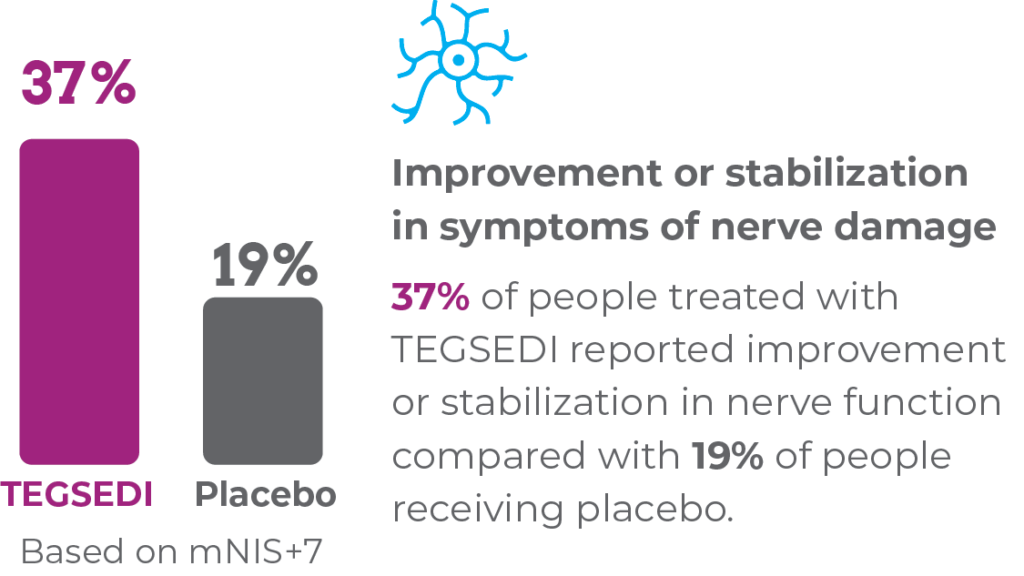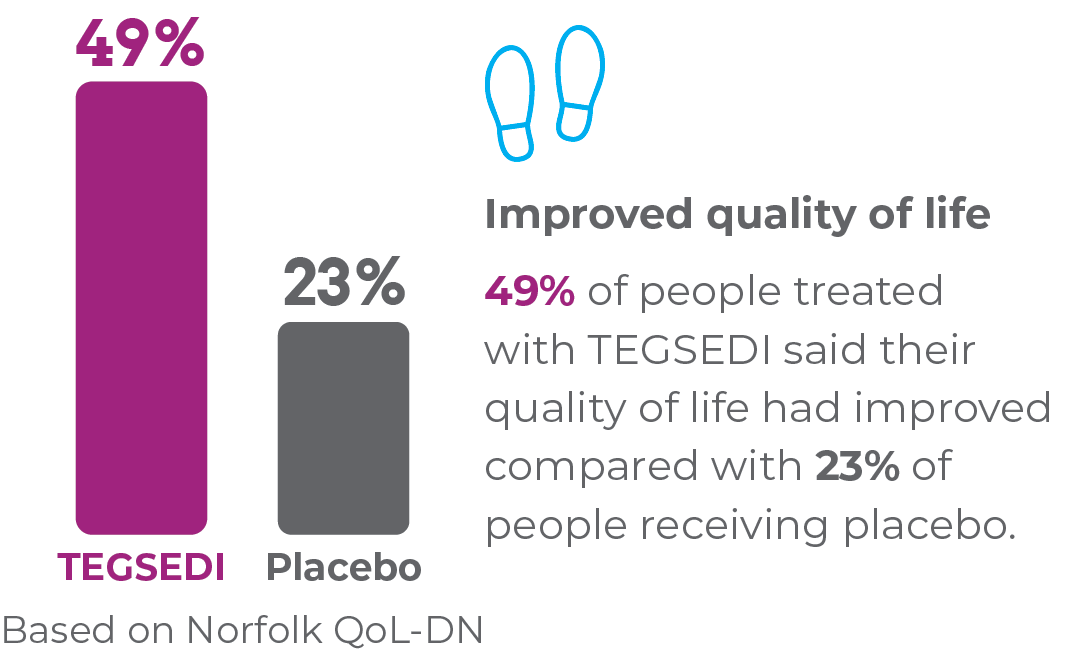INDICATION
TEGSEDI is a medicine that treats the polyneuropathy caused by hereditary transthyretin-mediated amyloidosis. TEGSEDI is for use in adults only.
IMPORTANT SAFETY INFORMATION
TEGSEDI can cause serious side effects including:
Low platelet counts (thrombocytopenia): TEGSEDI may cause the number of platelets in your blood to be reduced at any time during treatment. This is a common side effect of TEGSEDI. When your platelet count is too low, your body cannot form clots. You could have serious bleeding that could lead to death. Call your healthcare provider immediately if you have:
- Unusual bruising or a rash of tiny reddish-purple spots, often on the lower legs
- Bleeding from skin cuts that does not stop or oozes
- Bleeding from your gums or nose
- Blood in your urine or stools
- Bleeding into the whites of your eyes
- Sudden severe headaches or neck stiffness
- Vomiting or coughing up blood
- Abnormal or heavy periods (menstrual bleeding)
Kidney inflammation (glomerulonephritis): Your kidneys may stop working properly. Glomerulonephritis can lead to severe kidney damage and kidney failure that need dialysis. Call your healthcare provider immediately if you have:
- Puffiness or swelling in your face, feet, or hands
- New onset or worsening shortness of breath and coughing
- Blood in your urine or brown urine
- Foamy urine (proteinuria)
- Passed less urine than usual
Because of the risk of serious bleeding caused by low platelet counts and because of the risk of kidney problems, TEGSEDI is available only through a restricted program called the TEGSEDI Risk Evaluation and Mitigation Strategy (REMS) Program. Talk to your healthcare provider about how to enroll in the TEGSEDI REMS Program.
Do not use TEGSEDI if you have:
- A platelet count that is low
- Had kidney inflammation (glomerulonephritis) caused by TEGSEDI
- Had an allergic reaction to inotersen or any of the ingredients in TEGSEDI. See the end of the Medication Guide for a complete list of ingredients in TEGSEDI
Before you start TEGSEDI, tell your healthcare provider about all of your health issues, including if you:
- Have or had bleeding problems
- Have or had kidney problems
- Have received a liver transplant
- Are pregnant or plan to become pregnant. It is not known if TEGSEDI can harm your unborn baby
- Are breastfeeding or plan to breastfeed. It is not known if TEGSEDI can pass into your breast milk or harm your baby. Talk with your healthcare provider about the best way to feed your baby while you are taking TEGSEDI
Tell your healthcare provider about all the medicines you take, including prescription and over-the-counter medicines, vitamins, and herbal supplements. Especially tell your healthcare provider if you take vitamin A or beta-carotene supplements, blood thinners (anticoagulants), or drugs that affect blood clotting.
Required monitoring
Your healthcare provider will test your blood and urine to check your platelet counts and kidney and liver function before you start TEGSEDI. While you are receiving TEGSEDI, you will be monitored closely for symptoms, which includes checking your platelet counts every week (or more frequently as needed), kidney function every 2 weeks, and liver function monthly. If your healthcare provider has you stop taking TEGSEDI, you will need to continue to get your blood and urine tested for 8 more weeks after treatment.
TEGSEDI may cause serious side effects, including:
Stroke. TEGSEDI may cause a stroke. One person taking TEGSEDI had a stroke, which occurred within 2 days after the first dose. Get emergency help immediately if you have symptoms of stroke, including sudden numbness or weakness, especially on one side of the body; severe headache or neck pain; confusion; problems with vision, speech, or balance; droopy eyelids.
Inflammatory and immune system problems. Some people taking TEGSEDI had serious inflammatory and immune system problems. Symptoms of inflammatory and immune system problems included unexpected change in walking, weakness and spasms in legs, back pain, weight loss, headache, vomiting, and problems with speech.
Liver Effects. TEGSEDI may cause liver problems. Your healthcare provider should do laboratory tests to check your liver before you start TEGSEDI and monthly while you are using it. Stop taking TEGSEDI and tell your healthcare provider if you have symptoms that your liver may not be working right, which could include unexpected nausea and vomiting, stomach pain, being not hungry, yellowing of the skin, or having dark urine.
Allergic reactions. TEGSEDI may cause serious allergic reactions. These allergic reactions often occur within 2 hours after injecting TEGSEDI. Get emergency help immediately if you have any symptoms of a serious allergic reaction, including joint pain, chills, redness on palms of hands, muscle pain, chest pain, flushing, tremor or jerking movements, flu-like symptoms, high blood pressure, or difficulty swallowing.
Eye problems (low vitamin A levels). Treatment with TEGSEDI will lower the vitamin A levels in your blood. Your healthcare provider will tell you how much supplemental vitamin A to take every day; only take the amount they tell you to take. Call your healthcare provider if you get eye problems, such as having difficulty seeing at night or in low-lit areas (night blindness).
The most common side effects of TEGSEDI include injection site reactions (such as redness or pain at the injection site), nausea, headache, tiredness, low platelet counts (thrombocytopenia), and fever. These are not all of the possible side effects of TEGSEDI. Talk to your healthcare provider about any side effects you may be experiencing.
You are encouraged to report negative side effects of prescription drugs to the FDA. Visit www.fda.gov/medwatch or call 1-800-FDA-1088.
Please see Medication Guide and full Prescribing Information, including boxed WARNING.


